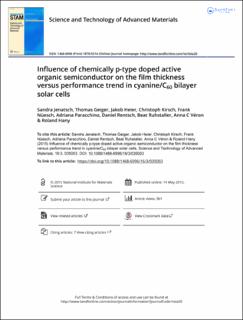Please use this identifier to cite or link to this item:
https://doi.org/10.21256/zhaw-1988Full metadata record
| DC Field | Value | Language |
|---|---|---|
| dc.contributor.author | Jenatsch, Sandra | - |
| dc.contributor.author | Geiger, Thomas | - |
| dc.contributor.author | Heier, Jakob | - |
| dc.contributor.author | Kirsch, Christoph | - |
| dc.contributor.author | Nüesch, Frank | - |
| dc.contributor.author | Paracchino, Adriana | - |
| dc.contributor.author | Rentsch, Daniel | - |
| dc.contributor.author | Ruhstaller, Beat | - |
| dc.contributor.author | Véron, Anna C. | - |
| dc.contributor.author | Hany, Roland | - |
| dc.date.accessioned | 2018-06-15T11:19:39Z | - |
| dc.date.available | 2018-06-15T11:19:39Z | - |
| dc.date.issued | 2015-05-14 | - |
| dc.identifier.issn | 1468-6996 | de_CH |
| dc.identifier.issn | 1878-5514 | de_CH |
| dc.identifier.uri | https://digitalcollection.zhaw.ch/handle/11475/6922 | - |
| dc.description.abstract | Simple bilayer organic solar cells rely on very thin coated films that allow for effective light absorption and charge carrier transport away from the heterojunction at the same time. However, thin films are difficult to coat on rough substrates or over large areas, resulting in adverse shorting and low device fabrication yield. Chemical p-type doping of organic semiconductors can reduce Ohmic losses in thicker transport layers through increased conductivity. By using a Co(III) complex as chemical dopant, we studied doped cyanine dye/C60 bilayer solar cell performance for increasing dye film thickness. For films thicker than 50 nm, doping increased the power conversion efficiency by more than 30%. At the same time, the yield of working cells increased to 80%. We addressed the fate of the doped cyanine dye, and found no influence of doping on solar cell long term stability. | de_CH |
| dc.language.iso | en | de_CH |
| dc.publisher | Taylor & Francis | de_CH |
| dc.relation.ispartof | Science and Technology of Advanced Materials | de_CH |
| dc.rights | https://creativecommons.org/licenses/by/3.0/ | de_CH |
| dc.subject | Organic solar cell | de_CH |
| dc.subject | Bilayer | de_CH |
| dc.subject | Cyanine dye | de_CH |
| dc.subject | Doping | de_CH |
| dc.subject.ddc | 621.3: Elektro-, Kommunikations-, Steuerungs- und Regelungstechnik | de_CH |
| dc.title | Influence of chemically p-type doped active organic semiconductor on the film thickness versus performance trend in cyanine/C60 bilayer solar cells | de_CH |
| dc.type | Beitrag in wissenschaftlicher Zeitschrift | de_CH |
| dcterms.type | Text | de_CH |
| zhaw.departement | School of Engineering | de_CH |
| zhaw.organisationalunit | Institute of Computational Physics (ICP) | de_CH |
| dc.identifier.doi | 10.21256/zhaw-1988 | - |
| dc.identifier.doi | 10.1088/1468-6996/16/3/035003 | de_CH |
| zhaw.funding.eu | No | de_CH |
| zhaw.issue | 3 | de_CH |
| zhaw.originated.zhaw | Yes | de_CH |
| zhaw.publication.status | publishedVersion | de_CH |
| zhaw.volume | 16 | de_CH |
| zhaw.publication.review | Peer review (Publikation) | de_CH |
| Appears in collections: | Publikationen School of Engineering | |
Files in This Item:
| File | Description | Size | Format | |
|---|---|---|---|---|
| 2015_ruhb_Influence_of_chemically_p_type.pdf | 2.02 MB | Adobe PDF |  View/Open |
Show simple item record
Jenatsch, S., Geiger, T., Heier, J., Kirsch, C., Nüesch, F., Paracchino, A., Rentsch, D., Ruhstaller, B., Véron, A. C., & Hany, R. (2015). Influence of chemically p-type doped active organic semiconductor on the film thickness versus performance trend in cyanine/C60 bilayer solar cells. Science and Technology of Advanced Materials, 16(3). https://doi.org/10.21256/zhaw-1988
Jenatsch, S. et al. (2015) ‘Influence of chemically p-type doped active organic semiconductor on the film thickness versus performance trend in cyanine/C60 bilayer solar cells’, Science and Technology of Advanced Materials, 16(3). Available at: https://doi.org/10.21256/zhaw-1988.
S. Jenatsch et al., “Influence of chemically p-type doped active organic semiconductor on the film thickness versus performance trend in cyanine/C60 bilayer solar cells,” Science and Technology of Advanced Materials, vol. 16, no. 3, May 2015, doi: 10.21256/zhaw-1988.
JENATSCH, Sandra, Thomas GEIGER, Jakob HEIER, Christoph KIRSCH, Frank NÜESCH, Adriana PARACCHINO, Daniel RENTSCH, Beat RUHSTALLER, Anna C. VÉRON und Roland HANY, 2015. Influence of chemically p-type doped active organic semiconductor on the film thickness versus performance trend in cyanine/C60 bilayer solar cells. Science and Technology of Advanced Materials. 14 Mai 2015. Bd. 16, Nr. 3. DOI 10.21256/zhaw-1988
Jenatsch, Sandra, Thomas Geiger, Jakob Heier, Christoph Kirsch, Frank Nüesch, Adriana Paracchino, Daniel Rentsch, Beat Ruhstaller, Anna C. Véron, and Roland Hany. 2015. “Influence of Chemically P-Type Doped Active Organic Semiconductor on the Film Thickness versus Performance Trend in Cyanine/C60 Bilayer Solar Cells.” Science and Technology of Advanced Materials 16 (3). https://doi.org/10.21256/zhaw-1988.
Jenatsch, Sandra, et al. “Influence of Chemically P-Type Doped Active Organic Semiconductor on the Film Thickness versus Performance Trend in Cyanine/C60 Bilayer Solar Cells.” Science and Technology of Advanced Materials, vol. 16, no. 3, May 2015, https://doi.org/10.21256/zhaw-1988.
Items in DSpace are protected by copyright, with all rights reserved, unless otherwise indicated.